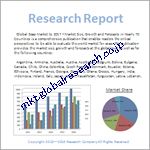目次
第1章 世界のベクターコントロール市場 エグゼクティブサマリー
1.1.ベクターコントロールの世界市場規模・予測(2022〜2032年)
1.2.地域別概要
1.3.セグメント別概要
1.3.1.技術別
1.3.2.制御方法別
1.3.3.ベクタータイプ別
1.3.4.最終用途別
1.4.主要トレンド
1.5.景気後退の影響
1.6.アナリストの推奨と結論
第2章.世界のベクターコントロール市場の定義と調査前提
2.1.調査目的
2.2.市場の定義
2.3.調査の前提
2.3.1.包含と除外
2.3.2.限界
2.3.3.供給サイドの分析
2.3.3.1.入手可能性
2.3.3.2.インフラ
2.3.3.3.規制環境
2.3.3.4.市場競争
2.3.3.5.経済性(消費者の視点)
2.3.4.需要サイド分析
2.3.4.1.規制の枠組み
2.3.4.2.技術の進歩
2.3.4.3.環境への配慮
2.3.4.4.消費者の意識と受容
2.4.推定方法
2.5.調査対象年
2.6.通貨換算レート
第3章.ベクターコントロールの世界市場ダイナミクス
3.1.市場促進要因
3.1.1.媒介性疾患の発生率の増加
3.1.2.ベクターコントロール技術の進歩
3.1.3.ベクター対策への政府の投資と資金援助
3.2.市場の課題
3.2.1.化学的防除法の環境と健康への影響
3.2.2.化学処理に対するベクター集団の耐性
3.2.3.総合的な媒介蚊管理戦略の実施の複雑さ
3.3.市場機会
3.3.1.生物学的防除法の採用拡大(遺伝子組み換え作物、滅菌昆虫)
3.3.2.総合的媒介蚊管理(IVM)アプローチへの注目の高まり
3.3.3.発展途上地域(アジア太平洋地域、中南米)における市場拡大
第4章.世界のベクターコントロール市場産業分析
4.1.ポーターの5フォースモデル
4.1.1.サプライヤーの交渉力
4.1.2.買い手の交渉力
4.1.3.新規参入者の脅威
4.1.4.代替品の脅威
4.1.5.競合他社との競争
4.1.6.ポーターの5フォースモデルへの未来的アプローチ
4.1.7.ポーター5フォースのインパクト分析
4.2.PESTEL分析
4.2.1.政治的
4.2.2.経済的
4.2.3.社会的
4.2.4.技術的
4.2.5.環境
4.2.6.法律
4.3.トップの投資機会
4.4.トップ勝ち組戦略
4.5.破壊的トレンド
4.6.業界専門家の視点
4.7.アナリストの推奨と結論
第5章.ベクターコントロールの世界市場規模・技術別予測 2022-2032
5.1.セグメントダッシュボード
5.2.ベクターコントロールの世界市場技術収入動向分析、2022年および2032年(百万米ドル/億ドル)
5.2.1.化学
5.2.2.物理的・機械的
5.2.3.生物学的
第6章.ベクターコントロールの世界市場規模・予測(防除方法別)2022-2032年
6.1.セグメントダッシュボード
6.2.世界のベクターコントロール市場防除方法の売上動向分析、2022年および2032年(百万米ドル/億ドル)
6.2.1.包括的
6.2.2.総合的なベクター管理
6.2.3.標的型
第7章.世界のベクター対策市場規模・予測:ベクタータイプ別 2022-2032
7.1.セグメントダッシュボード
7.2.ベクターコントロールの世界市場ベクタータイプの収益動向分析、2022年および2032年(百万米ドル/億ドル)
7.2.1.昆虫
7.2.2.げっ歯類
第8章.ベクターコントロールの世界市場規模・予測:最終用途別 2022-2032
8.1.セグメントダッシュボード
8.2.ベクターコントロールの世界市場エンドユースの収益動向分析、2022年および2032年(百万米ドル/億ドル)
8.2.1.住宅
8.2.2.商業用
8.2.3.農業
8.2.4.その他
第9章.ベクターコントロールの世界市場規模・地域別予測 2022-2032
9.1.北米のベクターコントロール市場
9.1.1.米国のベクターコントロール市場
9.1.1.1.技術別内訳規模と予測、2022〜2032年
9.1.1.2.防除方法別内訳規模・予測、2022年~2032年
9.1.2.カナダのベクターコントロール市場
9.2.ヨーロッパのベクターコントロール市場
9.2.1.イギリスのベクターコントロール市場
9.2.2.ドイツのベクターコントロール市場
9.2.3.フランスのベクターコントロール市場
9.2.4.スペインのベクターコントロール市場
9.2.5.イタリアのベクターコントロール市場
9.2.6.その他のヨーロッパのベクターコントロール市場
9.3.アジア太平洋地域のベクターコントロール市場
9.3.1.中国ベクターコントロール市場
9.3.2.インドのベクターコントロール市場
9.3.3.日本のベクターコントロール市場
9.3.4.オーストラリアのベクターコントロール市場
9.3.5.韓国のベクターコントロール市場
9.3.6.その他のアジア太平洋地域のベクターコントロール市場
9.4.ラテンアメリカのベクターコントロール市場
9.4.1.ブラジルのベクターコントロール市場
9.4.2.メキシコのベクターコントロール市場
9.4.3.その他のラテンアメリカのベクターコントロール市場
9.5.中東・アフリカのベクターコントロール市場
9.5.1.サウジアラビアのベクターコントロール市場
9.5.2.南アフリカのベクターコントロール市場
9.5.3.その他の中東・アフリカのベクターコントロール市場
第10章.競合他社情報
10.1.主要企業のSWOT分析
10.1.1.BASF SE
10.1.2.シンジェンタAG
10.1.3.バイエル
10.2.トップ市場戦略
10.3.企業プロフィール
10.3.1.BASF SE
10.3.1.1.主要情報
10.3.1.2.概要
10.3.1.3.財務(データの入手可能性による)
10.3.1.4.製品概要
10.3.1.5.市場戦略
10.3.2.シンジェンタAG
10.3.3.バイエル
10.3.4.モスキートコントロールサービス
10.3.5.住友化学
10.3.6.デング熱の撲滅
10.3.7.オキシテック
10.3.8.バイオテック・インターナショナル社
10.3.9.クラーク・モスキート・コントロール
10.3.10.アグバイテック社
10.3.11.デラバル
10.3.12.ヴァレント・バイオサイエンシズLLC
10.3.13.ベリリーライフサイエンス
10.3.14.インセクトリー・ソリューションズ
10.3.15 インツーケア
第11章.研究プロセス
11.1.研究プロセス
11.1.1.データマイニング
11.1.2.分析
11.1.3.市場推定
11.1.4.バリデーション
11.1.5.出版
11.2.研究属性
表1.ベクターコントロールの世界市場、レポートスコープ
表2.ベクターコントロールの世界市場 地域別推計・予測 2022-2032 (百万米ドル/億ドル)
表3.ベクターコントロールの世界市場:技術別2022年〜2032年の推定と予測(百万米ドル/億ドル)
表4.ベクターコントロールの世界市場:2022-2032年(百万米ドル/億米ドル)予測・評価
表5.ベクターコントロールの世界市場:ベクタータイプ別2022年〜2032年の推定と予測(百万米ドル/億米ドル)
表6.ベクター駆除の世界市場:エンドユース別推計・予測 2022-2032 (百万米ドル/億米ドル)
表7.北米のベクターコントロール市場の推定と予測 2022-2032 (百万米ドル/億ドル)
表8.米国のベクターコントロール市場のセグメント別見積もりと予測 2022-2032 (百万米ドル/億ドル)
表9.カナダのベクターコントロール市場の推定と予測 2022-2032 (百万米ドル/億ドル)
表10.ヨーロッパのベクターコントロール市場の推定と予測 2022-2032年 (百万米ドル/億ドル)
…
このリストは完全なものではなく、最終報告書には100以上の表が含まれています。リストは最終成果物で更新される可能性があります。
図1. ベクターコントロールの世界市場、調査手法
図2.ベクターコントロールの世界市場、市場予測手法
図3.世界市場規模の推定と予測手法
図4.ベクターコントロールの世界市場、主要動向2023年
図5.ベクターコントロールの世界市場、成長見通し2022年~2032年
図6.ベクターコントロールの世界市場、ポーターの5フォースモデル
図7.ベクターコントロールの世界市場、PESTEL分析
図8.ベクターコントロールの世界市場、バリューチェーン分析
図9. ベクター駆除の世界市場、セグメント別、2022年および2032年 (百万米ドル/億米ドル)
図10.ベクターコントロールの世界市場:地域別、2022年〜2032年(百万米ドル/億米ドル)
このリストは完全なものではなく、最終報告書には50以上の図表が含まれています。リストは最終成果物で更新される可能性があります。
————
The global vector control market is valued at approximately USD 19.88 billion in 2023 and is projected to grow at a compound annual growth rate (CAGR) of 6.2% during the forecast period from 2024 to 2032. Vector control refers to the methods and measures employed to control populations of disease-carrying organisms, such as mosquitoes and rodents, to prevent the spread of various infectious diseases, including malaria, dengue fever, and the Zika virus. The advancement in vector control technologies, combined with increasing awareness about disease outbreaks and rising health concerns, is driving substantial market growth. This market encompasses a broad range of technologies and approaches, such as chemical, physical, mechanical, and biological methods, each with distinct applications and effectiveness.The growth in the vector control market is being fueled by various factors, including the rising incidence of vector-borne diseases globally. Malaria alone remains one of the deadliest diseases worldwide, with millions affected annually, thus driving the demand for more efficient control measures. Additionally, the widespread impact of diseases like dengue fever and chikungunya has sparked governments and healthcare organizations to prioritize funding and implementation of advanced vector control strategies. Innovative biological control methods, such as the release of genetically modified organisms (GMOs) and sterilized insects, are gaining significant traction for their environmentally sustainable approach to curbing vector populations. These technologies present new opportunities for stakeholders in the market, alongside traditional chemical-based interventions, which continue to dominate in many regions.
However, despite the promising growth prospects, challenges related to the environmental and health impacts of chemical control methods remain a concern. The misuse of chemical pesticides, for instance, can lead to resistance among vector populations, making control efforts less effective. This is pushing the industry to focus more on integrated vector management (IVM) approaches, which combine multiple control methods to increase the overall efficacy and sustainability of interventions. IVM is a growing trend, and it is particularly relevant in settings with a high burden of vector-borne diseases, where comprehensive strategies are necessary to break the transmission cycle effectively. The complexity of these strategies is expected to drive further investments in research and development, which will contribute to the continued innovation in vector control technologies.
Regionally, the market for vector control is experiencing rapid growth across both developing and developed regions, each facing distinct challenges related to vector-borne diseases. North America and Europe, for instance, have seen increased investments in vector control technologies as part of broader public health strategies. The prevalence of tick-borne diseases such as Lyme disease in these regions has emphasized the need for more robust vector control measures. Meanwhile, the Asia Pacific (APAC) region is poised to experience the fastest growth in the forecast period due to the high incidence of diseases such as malaria, dengue, and Zika, particularly in tropical and subtropical regions. Governments in APAC countries are increasingly recognizing the importance of effective vector control programs, which is likely to drive market growth throughout the decade.
Major market players included in this report are:
• BASF SE
• Syngenta AG
• Bayer AG
• Mosquito Control Services
• Sumitomo Chemical Co., Ltd.
• Eliminate Dengue
• Oxitec Ltd
• Biotech International Ltd
• Clarke Mosquito Control
• AgBiTech Pty Ltd
• DeLaval Inc.
• Valent BioSciences LLC
• Verily Life Sciences
• Insectory Solutions
• In2Care
The detailed segments and sub-segments of the market are explained below:
By Technology:
• Chemical
• Physical & Mechanical
• Biological
By Control Method:
• Comprehensive
• Integrated Vector Management
• Targeted
By Vector Type:
• Insects
• Rodents
By End Use:
• Residential
• Commercial
• Agricultural
• Others
By Region:
North America
• U.S.
• Canada
Europe
• UK
• Germany
• France
• Spain
• Italy
• ROE
Asia Pacific
• China
• India
• Japan
• Australia
• South Korea
• RoAPAC
Latin America
• Brazil
• Mexico
Middle East & Africa
• Saudi Arabia
• South Africa
• RoMEA
Years considered for the study are as follows:
Historical year – 2022
Base year – 2023
Forecast period – 2024 to 2032
Key Takeaways:
• Market Estimates & Forecast for 10 years from 2022 to 2032.
• Annualized revenues and regional level analysis for each market segment.
• Detailed analysis of geographical landscape with Country level analysis of major regions.
• Competitive landscape with information on major players in the market.
• Analysis of key business strategies and recommendations on future market approach.
• Analysis of competitive structure of the market.
• Demand side and supply side analysis of the market.
❖ 免責事項 ❖
http://www.globalresearch.jp/disclaimer

